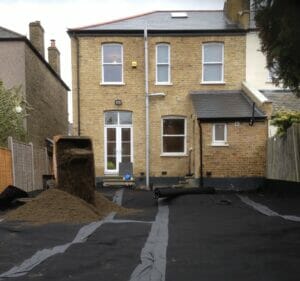Reclaiming a garden that’s been historically infested with Japanese knotweed is now possible using specialist root barriers. A system of reduced excavation and a scientifically tested root barrier for Japanese knotweed, installed both horizontally and vertically, is at the heart of the solution.
A brief explanation of the method
The process involves creating a root barrier tray that is installed below ground level, which is then filled. As the filling substance is normally soil this also makes the garden immediately usable for planting. The key objective is to provide an affordable knotweed remediation solution for the small to medium sized infestations normally found at a residential property.
The advantage of this method comes from the reduced depth of excavation required for knotweed remediation. This in turn lowers the cost of Japanese knotweed remediation by limiting the amount of expensive contaminated waste that needs to be disposed of at landfill.
The advantages
- An Immediate solution
- A lower cost than full depth excavation (to 2metres)
- Less reliance on landfill for waste
- A reduction in pesticide use
Considerations
- The methodology must be documented – a Japanese Knotweed management plan is best
- Root barrier installation must be part of an overall knotweed treatment and monitoring program. This is so that the impact of root barrier installation can be monitored and, if there is a need, any regrowth can be treated.
- Only specialist root barrier that is permeable and specifically tested against Japanese knotweed can be used.
The root barrier tray installation process
Survey the property for knotweed ensuring that, if present, a root barrier can be installed. Consideration needs to be given to trees, physical obstructions, and utilities – their presence may create limitations.
Knotweed Management Plan (KMP) that includes an assessment of the site, a methodology, and most importantly, a check of the proximity of the knotweed in neighbouring properties. It may be necessary to contact neighbours, particularly if access is required to their property.
Pre-treatment with a herbicide application will be completed to lower the invasive nature of the plant.
Reduce level dig undertaken to remove most of the viable rhizome. The depth of excavation is normally 0.5m to 1m, although this remains subjective and is based on what’s present at site.
Rhizome chase out to take place after completion of the reduced level excavation. Any remaining rhizome will normally be visible on the surface, and each of these must chased out. This is a task can often be performed by hand.
Inspection of the excavation to ensure that all rhizome has be dug out and removed, with only the weakest rhizomes left. Only Experience, qualified specialists will know what can left in the ground and what can’t. In practice, very little is ever remains and whatever does should not have the capacity to grow and extend out past the root barrier tray. However, if it ever did, it would be treated.
Preparation for root barrier installation takes place once the knotweed rhizome has been removed. The excavated area may well look like an archaeological dig; if that’s the case it will be necessary to grade out the land to even depths. This is important to prevent the formation of air pockets when the root barrier is laid.
Report and documentation will be complied to record the excavation work has been carried out. Information will include the location and depth of the excavation and the prior location of the removed rhizome. Further documentation will be added after installing root barrier, with all photos and plans added to the KMP.
Installation of the root barrier must follow the manufacturer’s instructions, but also best practice:
- The removal any sharp objects from the excavation prior to installation
- Limiting the number of joints in the root barrier tray
- Where possible the use of a single piece of barrier folded at the corners
- Ensuring that root barrier is returned vertically, so it finishes above soil level.
- Root barrier installed should be left, even during the monitoring period (normally 2 years after installation), so that all upstands remain freestanding i.e. not secured to a structure. This is because viable Knotweed rhizome would be expected to follow the root barrier (should it have the energy to do so) and then emerge immediately where the barrier ends. It is therefore important to allow that growth to happen within the subject properties land.

Adding uncontaminated top soil after a reduced level dig
Filling the root barrier tray with material free of knotweed and sharp objects is essential. This should be free draining material filled to a depth more than 0.5m to ensure that water logging does not become an issue.
The Science behind the solution
It is now readily accepted that the most viable part of knotweed is the rhizome found in the upper layers of the plants rooting profile. In some cases, Knotweed rhizome can extend to a depth of several metres; however, the rhizome and knotweed crown material found at shallow rooting depths often appear to be the most invasive. It follows that, excavating and removing soils contaminated with the most invasive part of Knotweed plant is essential.
Research published by; Lawson, Jacob & Fennell, Mark & Smith, Mark & Bacon, Karen. (2021). Regeneration and growth in crowns and rhizome fragments of Japanese knotweed (Reynoutria japonica).
The report concluded that:
“In residential garden settings crown and large fragment removal, could be used to successfully keep Knotweed in check”
Furthermore, RICS Japanese knotweed and Residential Property 2022 states:
“The cost of removing Japanese knotweed-contaminated soil and possibly protecting works with a root barrier can be significant. Guidance from the Environment Agency is that waste should be minimised and various proportionate solutions to reduce the amount of waste are often available”
Root barrier and compliance
First, it is most important to understand that any root barrier system is fitted to manufacturer’s instructions and in accordance with current best practice; a good guide is the Property Care Association Guidance Note: Root Barrier and Japanese Knotweed Remediation.
Utilising root barrier as part of a knotweed remediation solution is supported by
RICS, as documented in their publication Japanese knotweed and Residential Property 2022 states:
“Providing root barriers along the boundary may appear an attractive option to lenders who require a straightforward, time-limited solution”.
Crucially, the same document states that “Guarantees issued following root barrier installation will be dependent on a supporting monitoring/herbicide treatment programme”.
This means that anyone preparing for root barrier installation, must firstly write a knotweed management plan. This should fully detail the methodology for root barrier installation, identifying the limitations and constraints – having a KMP is a prerequisite for an Insurance Backed Guarantee (IBG).
Root barriers and neighbours
A KMP should include the potential impact on neighbouring properties. Where there could be an impact, or Japanese knotweed is present, it essential that there is acceptance of the KMP and that there is permission to monitor and, if need be, treat any resulting knotweed growth.
That’s why it’s important to involve the neighbours as early as possible if you can.
Treatment and monitoring
In scenarios where root barrier is not used, and a plan is put in place, it would be necessary to treat neighbouring properties if knotweed was close to or had already crossed a property boundary.
Neighbours must be made aware of what’s happening; management plans need to be discussed, especially the limitations and threats of the proposal. Neighbours will need to sign off for treatment access and monitoring within their gardens.
When used correctly, root barrier can reduce the need for treatment in neighbouring properties and, in some cases, limit engagement to monitoring only. Where knotweed is already within the neighbouring property treatment must be seen as a prerequisite regardless of root barrier.
Conclusion
Professionally installed root barrier can provide a time-limited solution that reduces waste and pesticide use. It must be used in conjunction with a herbicide treatment and monitoring program and include a KMP and IBG. It’s also essential that the whole package receives the buy in of the neighbours.
Do you need help or advice about excavation or root barrier for Japanese knotweed? Call 0203 174 2187 or 01202 816134 to talk to one of our consultants.

